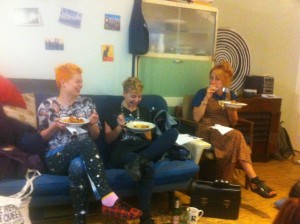FUCK THAT FOURTH WALL: operating notes for my personal theatre manifesto

The view from my Phone Whore chair at the Brixton kitchen show. There is simply NO ROOM for the fourth wall. Hell, there’s barely room for the two actual walls and the refrigerator!
Anyone who comes to one of my bar shows—Smut Slam and now BEDx—may have seen me flitting around in the half-hour before the show, chatting with box office and volunteers and most especially the early-arriving audience members. You might write that off as hostess jitters, and you would not be entirely wrong. But there’s more to it than that. I am trying to bring everyone into the show, wandering the boundaries of the room and gently nudging people in.
It’s part of my practice of breaking down the fourth wall, which I knew was a thing for me, but I hadn’t realized how much until five days ago, when I produced my first BEDx event in Montreal. BEDx is a simple concept: four presenters on sex/sexuality topics, 10 minutes each of geeking out plus Q&A, in the back room of a bar. One of the presenters had to drop out, so I rode into the gap on one of my favorite hobby horses, the intersection of performance space and sexual content. “Fuck That Fourth Wall,†I called my presentation; it was all about how I try to lower or eliminate perceived barriers for comprehension or empathy for audiences at my usually sexually explicit shows. Even before I got up on stage that night, I found myself doing the thing I was so keen on to talk about. It’s part of what I have to do, to make these shows work.
See, the fourth wall must be fucked with, for any public presentation about sex. Even the most starched-up, government-sponsored lecture series will have a Q&A. And for the more radical, intense, graphic, and/or personal moments that pepper my shows, I need to pull down the wall by whatever means necessary, using whatever little tricks I’ve found, accidental or deliberate, that can bring people in past that damned fourth wall.
This wall is the accepted convention that, in that theatrical environment, delineates the world of the actors from the “real world” that the audience is in. “Breaking the fourth wall” involves acknowledging the observer/audience as observer, and/or acknowledging the container for the work of art. For me, it is about bringing the audience in to inhabit the same space as I do.
For example, I am acutely aware of stage height. Especially for the plays in which I am talking to the audience for all or part of it—Phone Whore, for | play, The Pretty One, soon nerdfucker—performing on a noticeably elevated stage means that I will be literally talking down to them. Elevation also heightens (hah!) the sense that “this is a presentation or performance,†adding to the metaphorical distance that just gets in my way. For Smut Slams, I seek out venues where the mic stand can be at floor level. Why? I have a hard enough time coaxing people up. I don’t want to freak out non-performer tellers by making them go up and down steps—someone inevitably will bite it, owing to nerves—and then stand there in a brightly lit stage.
I like to start the show in the room, or make my entrance through it, where possible. I saw the effectiveness of this in 2013, at the Edinburgh Fringe. I was performing Phone Whore in the basement of a bar, which had no wings and only 15 minutes between shows. I was forced to see the audience as I was setting up, but rather than get stressed out about it, I decided to use that time to socialize while setting out my props. Now I do that with Phone Whore everywhere, even if I could do the conventional entrance from the side of the stage, even if there is enough space backstage to hold two productions of The Nutcracker side by side, including the growing Christmas trees. I will climb up into the raked seats to talk with people. It makes my dash for the phone more authentic at the beginning of the play, and gives me another five to 15 minutes of time to build rapport. And it makes the point that the entire room is where the show is set.
I also look at the size of the venue. From a strictly business point of view, we often hear, “Don’t hire a venue that you can’t fill up,†which is solid advice; you’re just paying for those empty seats. Or from a taking-care-of-the-performer’s-ego point of view: “It feels better to have 30 people in a 40-seat venue than in an 80-seat venue.†This is also true. My real interest in small venues is the build-in intimacy. Don’t get me wrong: occasionally selling out a 100-seat venue feels great! But honestly, one of the best Phone Whores I ever did was in a kitchen in Brixton, UK. It was a very large, open-plan kitchen/dining room combo, but believe me, 30 people was a tight fit, and it was amazing!
In addition to basic structural considerations in the venue, I really do find that circulating with audience draws people into the space and action of the show as well. You can’t get away with hiding back there. I’ve already greeted you; I know you’re there. This is obviously true for such hopefully participatory events as Smut Slam and BEDx, but I do it for my plays, too.
The thing is, theatre doesn’t always get to be choosy around where it is staged. There are challenges that strengthen the fourth wall, which I almost always want to break down. My sexual content thrives when I bust through that wall; it needs air to breathe and room to flow between my audiences and me. But at least I have this toolbox to do the work, and I have found that the tools can be as simple as just stopping by a table and saying hi.
*****
Together with you, I get to keep outfitting that toolbox! Become a patron of mine over on Patreon and help me dismantle EVERYTHING that needs to go.
